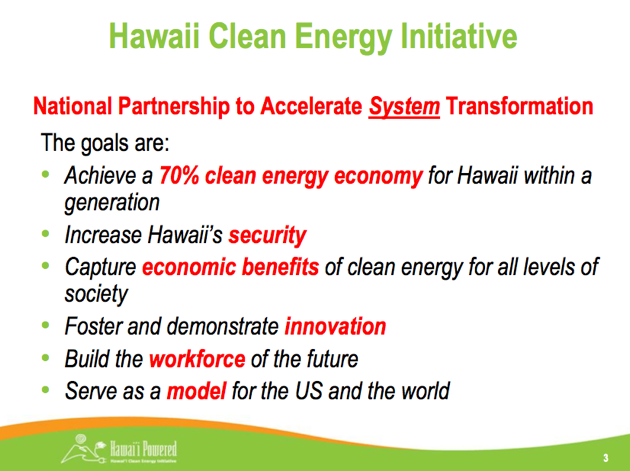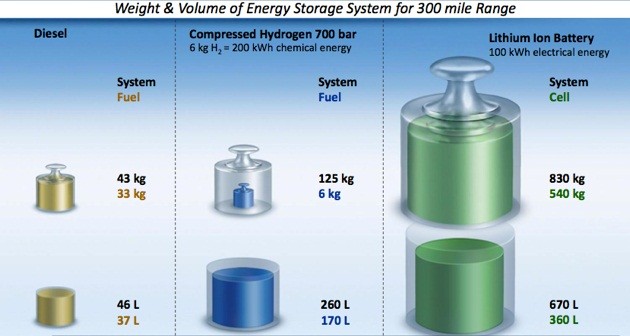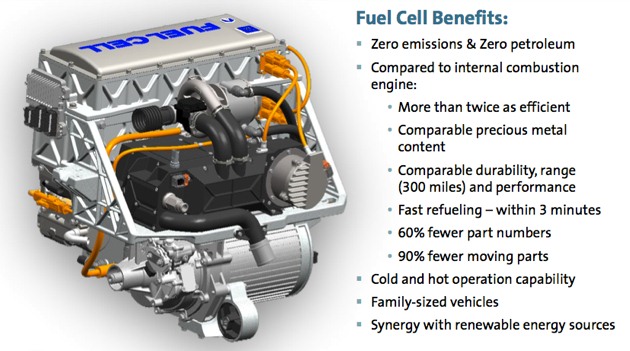Hawaii is set to get the first hydrogen fueling infrastructure in the United States thanks to a pilot project announced today by General Motors and The Gas Company. The Gas Company is the local natural gas and propane utility on the island state. Hawaii makes an ideal location for testing new transportation technologies as a result of its isolation, and the relatively small size of the islands means that you can never get all that far from the fueling network.
The Gas Company (TGC) has been producing both synthetic natural gas (SNG) and hydrogen for several years. The SNG that it distributes to customers through its island pipeline network is currently blended with five percent hydrogen, a percentage that could be increased as needed.
The new pilot project will set up a network of 20-25 hydrogen filling stations on Oahu that will tap directly into the pipeline network. Such a network can provide fuel access to to most drivers within a 10 minute drive. Pure hydrogen can be separated from the flow through a pressure swing absorption system and then used to fill fuel cell vehicles. Continue reading after the jump.
[Source: General Motors]
With its tropical and remote location, Hawaii has good reason to want to use renewable energy sources since all fossil fuels have to be imported at considerable cost. While sun and wind are both plentiful in Hawaii, the fact that they are not constant makes it problematic for grid stability. The ability to store hydrogen gives it an advantage, especially if it is produced from renewable sources. Hawaii has a goal of achieving 70 percent clean energy within a generation.

Charlie Freese, the director of GM's hydrogen activities discussed the rationale for hydrogen and emphasized energy density. While GM is working on battery electric and range-extended vehicles for various applications, getting longer range is problematic with batteries. Getting a 300 mile range out of diesel, hydrogen or lithium ion batteries requires energy storage systems that weigh 43, 125 and 830 kilograms respectively. Because of this, the future will likely include multiple solutions for different applications.

GM is actively working to develop a mass producable fuel cell system by 2015. The new generation design and manufacturing processes will be able to get precious metal content down to a level comparable to the catalytic converters on current internal combustion vehicles. That will dramatically reduce the cost of the stack. A stack similar in size to current four cylinder engines could provide sufficient electrical output to propel a family sized vehicle.
Jeff Kissell of TGC described the company's synthetic natural gas production. Most of the current gas is produced from naphtha but that is being transitioned to using plant and animal fats as the feedstock. The process also generates hydrogen and liquid byproducts, including green diesel fuel. The current system is able to produce about 7,000 kg of hydrogen per day all of which can be used as vehicle fuel. According to Kissell, that capacity can be doubled if needed. The hydrogen is mixed with the synthetic gas and pumped through the pipelines.

Pressure swing absorption systems at the filling stations separate the hydrogen for fueling and release the rest of the gas back into the pipeline for customers to use. The hydrogen stations would be installed at existing filling stations on the island in partnership with station owners. The cost of adding hydrogen filling capability at an existing station is estimated by TGC's Jeff Kissell at $300,000 to $500,000. Because TGC is state regulated like utilities elsewhere, the company will be filling a tariff for the cost of hydrogen to the filling stations. Although no specific number was given, Kissell estimates that it will be comparable to the cost of gasoline.
With GM's first commercially available fuel cell vehicles still several years out, the automaker is looking to move some of its fleet of fuel cell Chevrolet Equinoxes from Project Driveway to the island. According to Freese, the first of those vehicles is already on Oahu and GM will be making arrangements with current users to redeploy more vehicles. There are currently 119 vehicles in the fleet and they have accumulated more than 1.4 million miles over the past three years. Until the retail vehicles are available only a few stations will be installed. As commercial introduction gets closer a full network of stations will be available.
PRESS RELEASE
GM Looks to Hawaii for Hydrogen Infrastructure Pilot
Collaboration with The Gas Company Plans Stations on Oahu for Fuel Cells
Detroit/Honolulu, May 11 – Abundant hydrogen is available on the island of Oahu to power a ramp up of fuel cell vehicles through a General Motors collaboration with The Gas Company (TGC), Hawaii's major gas energy provider, the two companies announced Tuesday.
TGC produces hydrogen along with synthetic natural gas and delivers it in its utility gas stream, with more than 5 percent hydrogen content today. Through a proprietary separation process, TGC plans to tap into its 1,000-mile utility pipeline system at key locations and separate the hydrogen for use by local fueling stations for fuel cell vehicles.
"This is the type of enabler that a hydrogen transportation infrastructure needs because it addresses both the source of the hydrogen and a feasible way to deliver it for fuel cell vehicle use," said Charles Freese, executive director of GM Global Fuel Cell Activities. "The Hawaii infrastructure could eventually support tens of thousands of fuel cell vehicles.
"Hawaii is uniquely positioned and motivated to make hydrogen-powered fuel cell transportation a reality because it depends on imported petroleum for 90 percent of its energy," he said.
The state is committed to reducing petroleum use by 70 percent through a combination of renewable energy resources, conservation and efficiency. The use of hydrogen as a transportation fuel could be a key contributor.
"We have been delivering as much as 12 percent hydrogen made from renewable sources to our gas customers over the last two to three years and expect we can deliver even greater quantities of hydrogen as demand increases," said Jeffrey Kissel, president and CEO of TGC. "By delivering hydrogen through our existing infrastructure as vehicle fuel wherever we have gas, The Gas Company expands its key role of supporting Hawaii's clean energy future."
Depending how the pricing for the hydrogen is set, it could be available at the equivalent price of gasoline or less.
GM, which has invested more than $1.5 billion in fuel cell transportation in the last 15 years, is developing a production-intent fuel cell system that could be ready for commercialization in 2015. Current Chevrolet Fuel Cell vehicles are part of Project Driveway, the world's largest demonstration of fuel cell vehicles, which has amassed nearly 1.4 million miles of real-world driving by thousands of people since 2007.
U.S. Senator Dan Inouye, D-Hawaii, said he supports the pilot project.
"My small role was one of introduction between these two companies, not that many months ago, which resulted in this business announcement today," Inouye said. "It is an important step forward in the establishment of a hydrogen transportation infrastructure upon which new fleets, both military and civilian, can be tested and utilized. I am committed to support the resourcing of this endeavor.
"Every step to reduce our dependency on foreign oil is a move forward," he said.
The GM-TGC collaboration is the leading edge of a broad consortium of federal and state, non-profit and education organizations that is forming to develop a Hawaii Hydrogen Initiative as part of an integrated energy solution for Hawaii's future.
About General Motors: General Motors, one of the world's largest automakers, traces its roots back to 1908. With its global headquarters in Detroit, GM employs 217,000 people in every major region of the world and does business in some 140 countries. GM and its strategic partners produce cars and trucks in 34 countries, and sell and service these vehicles through the following brands: Buick, Cadillac, Chevrolet, FAW, GMC, GM Daewoo, Holden, Opel, Vauxhall and Wuling. GM's largest national market is the United States, followed by China, Brazil, Germany, the United Kingdom, Canada, and Italy. GM's OnStar subsidiary is the industry leader in vehicle safety, security and information services. General Motors acquired operations from General Motors Corporation on July 10, 2009, and references to prior periods in this and other press materials refer to operations of the old General Motors Corporation. More information on the new General Motors can be found at HYPERLINK "http://www.gm.com"www.gm.com.
About The Gas Company: The Gas Company LLC has been in business since 1904 and has a workforce of 300. It provides clean, reliable and energy-efficient gas to residential, business and government customers throughout the state of Hawaii - Oahu, Maui, Hawaii, Kauai, Molokai and Lanai. TGC manufactures synthetic natural gas (SNG) and hydrogen at its high-capacity plant located on Oahu for delivery through a 1,000-mile pipeline network, and supplies propane gas (LPG) statewide. More information on TGC is available at www.hawaiigas.com.
The Gas Company (TGC) has been producing both synthetic natural gas (SNG) and hydrogen for several years. The SNG that it distributes to customers through its island pipeline network is currently blended with five percent hydrogen, a percentage that could be increased as needed.
The new pilot project will set up a network of 20-25 hydrogen filling stations on Oahu that will tap directly into the pipeline network. Such a network can provide fuel access to to most drivers within a 10 minute drive. Pure hydrogen can be separated from the flow through a pressure swing absorption system and then used to fill fuel cell vehicles. Continue reading after the jump.
[Source: General Motors]
With its tropical and remote location, Hawaii has good reason to want to use renewable energy sources since all fossil fuels have to be imported at considerable cost. While sun and wind are both plentiful in Hawaii, the fact that they are not constant makes it problematic for grid stability. The ability to store hydrogen gives it an advantage, especially if it is produced from renewable sources. Hawaii has a goal of achieving 70 percent clean energy within a generation.

Charlie Freese, the director of GM's hydrogen activities discussed the rationale for hydrogen and emphasized energy density. While GM is working on battery electric and range-extended vehicles for various applications, getting longer range is problematic with batteries. Getting a 300 mile range out of diesel, hydrogen or lithium ion batteries requires energy storage systems that weigh 43, 125 and 830 kilograms respectively. Because of this, the future will likely include multiple solutions for different applications.

The challenge is to balance electric drive efficiency and energy cost advantages versus energy system storage mass, volume and refuel time penalties
GM is actively working to develop a mass producable fuel cell system by 2015. The new generation design and manufacturing processes will be able to get precious metal content down to a level comparable to the catalytic converters on current internal combustion vehicles. That will dramatically reduce the cost of the stack. A stack similar in size to current four cylinder engines could provide sufficient electrical output to propel a family sized vehicle.
Jeff Kissell of TGC described the company's synthetic natural gas production. Most of the current gas is produced from naphtha but that is being transitioned to using plant and animal fats as the feedstock. The process also generates hydrogen and liquid byproducts, including green diesel fuel. The current system is able to produce about 7,000 kg of hydrogen per day all of which can be used as vehicle fuel. According to Kissell, that capacity can be doubled if needed. The hydrogen is mixed with the synthetic gas and pumped through the pipelines.

Pressure swing absorption systems at the filling stations separate the hydrogen for fueling and release the rest of the gas back into the pipeline for customers to use. The hydrogen stations would be installed at existing filling stations on the island in partnership with station owners. The cost of adding hydrogen filling capability at an existing station is estimated by TGC's Jeff Kissell at $300,000 to $500,000. Because TGC is state regulated like utilities elsewhere, the company will be filling a tariff for the cost of hydrogen to the filling stations. Although no specific number was given, Kissell estimates that it will be comparable to the cost of gasoline.
With GM's first commercially available fuel cell vehicles still several years out, the automaker is looking to move some of its fleet of fuel cell Chevrolet Equinoxes from Project Driveway to the island. According to Freese, the first of those vehicles is already on Oahu and GM will be making arrangements with current users to redeploy more vehicles. There are currently 119 vehicles in the fleet and they have accumulated more than 1.4 million miles over the past three years. Until the retail vehicles are available only a few stations will be installed. As commercial introduction gets closer a full network of stations will be available.
PRESS RELEASE
GM Looks to Hawaii for Hydrogen Infrastructure Pilot
Collaboration with The Gas Company Plans Stations on Oahu for Fuel Cells
Detroit/Honolulu, May 11 – Abundant hydrogen is available on the island of Oahu to power a ramp up of fuel cell vehicles through a General Motors collaboration with The Gas Company (TGC), Hawaii's major gas energy provider, the two companies announced Tuesday.
TGC produces hydrogen along with synthetic natural gas and delivers it in its utility gas stream, with more than 5 percent hydrogen content today. Through a proprietary separation process, TGC plans to tap into its 1,000-mile utility pipeline system at key locations and separate the hydrogen for use by local fueling stations for fuel cell vehicles.
"This is the type of enabler that a hydrogen transportation infrastructure needs because it addresses both the source of the hydrogen and a feasible way to deliver it for fuel cell vehicle use," said Charles Freese, executive director of GM Global Fuel Cell Activities. "The Hawaii infrastructure could eventually support tens of thousands of fuel cell vehicles.
"Hawaii is uniquely positioned and motivated to make hydrogen-powered fuel cell transportation a reality because it depends on imported petroleum for 90 percent of its energy," he said.
The state is committed to reducing petroleum use by 70 percent through a combination of renewable energy resources, conservation and efficiency. The use of hydrogen as a transportation fuel could be a key contributor.
"We have been delivering as much as 12 percent hydrogen made from renewable sources to our gas customers over the last two to three years and expect we can deliver even greater quantities of hydrogen as demand increases," said Jeffrey Kissel, president and CEO of TGC. "By delivering hydrogen through our existing infrastructure as vehicle fuel wherever we have gas, The Gas Company expands its key role of supporting Hawaii's clean energy future."
Depending how the pricing for the hydrogen is set, it could be available at the equivalent price of gasoline or less.
GM, which has invested more than $1.5 billion in fuel cell transportation in the last 15 years, is developing a production-intent fuel cell system that could be ready for commercialization in 2015. Current Chevrolet Fuel Cell vehicles are part of Project Driveway, the world's largest demonstration of fuel cell vehicles, which has amassed nearly 1.4 million miles of real-world driving by thousands of people since 2007.
U.S. Senator Dan Inouye, D-Hawaii, said he supports the pilot project.
"My small role was one of introduction between these two companies, not that many months ago, which resulted in this business announcement today," Inouye said. "It is an important step forward in the establishment of a hydrogen transportation infrastructure upon which new fleets, both military and civilian, can be tested and utilized. I am committed to support the resourcing of this endeavor.
"Every step to reduce our dependency on foreign oil is a move forward," he said.
The GM-TGC collaboration is the leading edge of a broad consortium of federal and state, non-profit and education organizations that is forming to develop a Hawaii Hydrogen Initiative as part of an integrated energy solution for Hawaii's future.
About General Motors: General Motors, one of the world's largest automakers, traces its roots back to 1908. With its global headquarters in Detroit, GM employs 217,000 people in every major region of the world and does business in some 140 countries. GM and its strategic partners produce cars and trucks in 34 countries, and sell and service these vehicles through the following brands: Buick, Cadillac, Chevrolet, FAW, GMC, GM Daewoo, Holden, Opel, Vauxhall and Wuling. GM's largest national market is the United States, followed by China, Brazil, Germany, the United Kingdom, Canada, and Italy. GM's OnStar subsidiary is the industry leader in vehicle safety, security and information services. General Motors acquired operations from General Motors Corporation on July 10, 2009, and references to prior periods in this and other press materials refer to operations of the old General Motors Corporation. More information on the new General Motors can be found at HYPERLINK "http://www.gm.com"www.gm.com.
About The Gas Company: The Gas Company LLC has been in business since 1904 and has a workforce of 300. It provides clean, reliable and energy-efficient gas to residential, business and government customers throughout the state of Hawaii - Oahu, Maui, Hawaii, Kauai, Molokai and Lanai. TGC manufactures synthetic natural gas (SNG) and hydrogen at its high-capacity plant located on Oahu for delivery through a 1,000-mile pipeline network, and supplies propane gas (LPG) statewide. More information on TGC is available at www.hawaiigas.com.


Sign in to post
Please sign in to leave a comment.
Continue